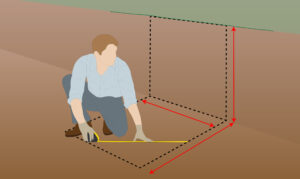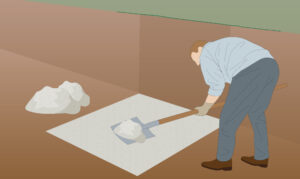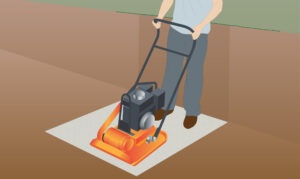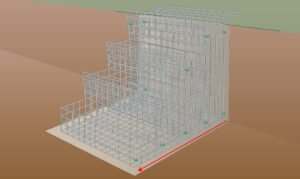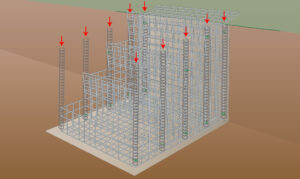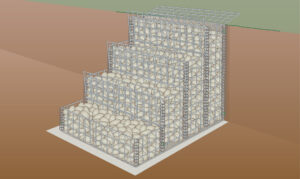How to Make Gabion Steps
Below you will find a detailed guide on how to make gabion steps.

- Experience Required: Medium
- Tools Required: Protective gloves, Tape measure, Shovel, Spirit level, Hammer, Wire cutters, Screws, Plate compactor
- Materials Required: 5mm Gabion baskets, Stone, Timber treads, Helicals, Tying wire or Cable ties, Type 1 gravel, Geotextile (optional)
Step 1) Measure Up Your Area
- Begin by examining the area where you plan to place the new steps.
- Measure the length and width of your structure according to the available space.
- Also, measure the total height (rise) to get an idea of how many steps you’ll need in total.
Step 2) Calculate Gabion Sizes
- Sketch a plan for your stair following these guidelines: each step’s height (rise) should be around 15-22.5cm & each step’s depth (tread) should be around 30cm.
- Calculate gabion sizes and quantity needed.
- Remember to calculate how much stone you’ll need.
Step 3) Mark the Area
- Mark the area with spray paint or strings.
- Remember to add an extra 10cm on each side for proper alignment and stability.
Step 4) Create Foundation
- Make sure the stair foundation is level for stability.
- Also, incorporate a slight slope towards the front for drainage to prevent water from collecting.
Step 5) Add Basecourse
- Add a layer of Type 1 gravel according to the height of the structure:
- For 1m high stairs, use 10cm of basecourse.
- For 2m high stairs, use 20cm of basecourse.
- For stairs 3m high or taller, use 30cm of basecourse.
Step 6) Compact Basecourse
- Use a plate compactor to compact the basecourse thoroughly, ensuring stability.
Step 7) Add Geotextile (Optional)
- Line the bottom and sides of the structure with geotextile fabric to prevent soil erosion.
Step 8) Fold up Baskets
- Fold up and secure the vertical corners of each basket with 2 cable ties: 1 at top and 1 at the bottom of the corner.
Step 9) Position the Baskets
- Position the boxes starting with the largest one at the back and working towards the shortest one.
- Make sure to push the adjoining corners as close together as possible.
- The lids should be folded upwards, make sure they’re not falling behind the baskets.
Step 10) Attach them Together
- Secure the corners of the adjoining steps with a helical to prevent movement.
- The helical should connect the corners of two gabions.
Step 11) Trim Excess
- Cut off the excess lengths of helical where needed.
- Fold the ends of the helicals downwards with pliers.
- Additionally, cut off any excess geotextile.
Step 12) Fill with Stones
- Fill each gabion basket with the calculated amount of stones.
- Leave a slight gap at the top to allow space for the timber.
Step 13) Attach Timber Treads
- Place a timber on top of the stones on both sides of the stair. Close and secure the lid with a piece of wire or cable ties.
- Position timber treads onto the lid and screw them to the timber under the wires.
- Repeat these steps until you complete the process.
Step 14) Check for Stability

- Inspect the completed garden stairs and check for stability.
- Make any necessary adjustments to ensure safety and durability.
WARNINGS
- When considering how to build gabion steps, it’s advisable to opt for 5mm baskets over the 3mm and 4mm ones to prevent bulging, thus ensuring structural stability and strength.
- To avoid water accumulation and any accidents, maintain a slight slope on step treads and plan drainage, especially for sloped garden stairs.
- While deciding how to build garden steps, make sure to maintain consistent height, width, and, in the case of straight stairs, also depth, to avoid stumbles or falls.
FURTHER READING
- How to Assemble a Gabion Basket – Instructions on how to assemble baskets
- How to Fill Gabions – Learn how to fill cages using different methods
- Stone Quantity for Gabions – A guide showing you how to calculate the required stone quantity for baskets

